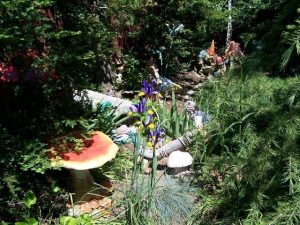One year, I moved about 200 plants. I asked myself, “Why was that necessary?” Since moving plants already stressed by the long hot summer is risky, there were compelling reasons: too big, too close to neighboring plants, too much or too little sun. In most instances, the underlying reality was, I should have paid better attention to plant characteristics, needs and intended location to choose the right plant for the right place.
The Mother Lode has its own unique sense of place characterized by stately oaks, towering pines and subdued colors. Acknowledging that reality, I now look for plants originating in the Mother Lode or native to California.
Most of these plants do best when planted in the fall. Soil temperatures are warm, but air temperatures are beginning to cool. Soaking rains will appear during the fall and winter. It’s time to do a little advance analysis of the right plant for the right place.
In the Mother Lode, there are often special factors to consider such as poorly draining clay soil; rocky, slippery slopes; wandering, hungry deer; intense, unfiltered summer sun; and heavy snow that can break brittle branches.
Often plants are selected to perform a specific function. Deciduous trees usually provide summer shade and access to winter sun. Dense evergreen trees and shrubs are used for privacy screens. When planning a habitat garden, its placement is critical. Not even the right bird-attracting plants will be successful if human and pet activity scares the birds away.
Use cultural preferences (light, moisture, drainage, and soil pH) to select a plant that will thrive in a specific location. Sometimes, existing conditions can be modified to accommodate plant preferences-limb up nearby trees for more light, create berms and plant high to improve drainage, or install a low volume drip irrigation system that takes water directly to the roots. It is far better, however, to select a plant that thrives with what is already there.
Plan so plants will not have to be moved or cut down later. Some situations to consider are: overhead or buried utility lines, septic systems, or nearby trees that will create shade or dense root systems. Consider the ultimate size that trees will grow.
Sometimes, requirements of neighboring plants are critical. An example is native oaks that will not tolerate summer irrigation. The best thing to plant under them may be nothing. However, some dry shade-loving plants-deergrass (Muhlenbergia rigens), yarrow (Achillea), Pacific coast iris, Oregon grape (Mahonia), and sticky monkey flower (Mimulus aurantiacus)-may be planted at or beyond the drip line and watered infrequently or not at all.
Fire safety issues also indicate right plant, right place. If it is tall and touching the house or roof, it is not the “right plant” in the “right place.” Plants in close proximity to structures should be low growing, fire resistant and moist-such as sedums or thyme. Trees and shrubs should be pruned or removed to prevent the possibility of fires leaping from one to the other. Dead trees and shrubs should be removed to reduce fire hazards.
Fortunately, there are resources to aid in deciding “right plant: right place.” Ask a Master Gardener for advice or pick up a copy of the Master Gardener book “Sharing the Knowledge, Gardening in the Mother Lode.” Browse through “Plants and Landscapes for Summer-Dry Climates” by East Bay Municipal Utility District. A new resource is “Reimagining the California Lawn,” by Carol Bornstein, David Fross, and Bart O’Brien.
Marlys Bell is a Tuolumne County Master Gardener who is creating a demonstration garden on her property consisting of plants that thrive in the Mother Lode. She frequently writes about “lessons learned.”


